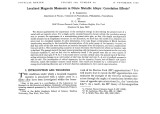TO
1 - 25 of 13
| Creator | Title | Description | Subject | Date | ||
|---|---|---|---|---|---|---|
| 1 |
 | Mattis, Daniel C. | Anomalous skin effect in a magnetic field | A classical and quantum mechanical derivation of cyclotron resonance in metals is given. The classical result differs slightly from that obtained by Azbel and Kaner. The quantum derivation yields the same result as the classical calculation except that in the limit of low quantum numbers or high m... | Cyclotron resonance; Skin effect; Quantum transport | 1958-07 |
| 2 |
 | Mattis, Daniel C. | Anomaly in spin-wave spectrum of magnetic metals | It is pointed out that in the band theory of magnetism the magnons have frequencies comparable to the Fermi energy. Therefore, in the calculation of the magnon spectrum of iron, nickel, cobalt, etc., it is the time- or frequency-dependent response function of the electrons which is used, and this ... | Magnetic metals | 1966-11 |
| 3 |
 | Mattis, Daniel C. | Effects of orbital degeneracy on a magnetic impurity in a nonmagnetic metal | We study the Green's-function equations for a version of the two-orbital Anderson model of a magnetic impurity, in an approximation scheme that displays the logarithmic anomalies and enables the Kondo temperature Tĸ to be calculated as a function of the parameters. The nature of the solutions is ex... | Orbital degeneracy; Magnetic impurities; Nonmagnetic metal; Kondo temperature; Anomalous resonances | 1969-02 |
| 4 |
 | Mattis, Daniel C. | Ferromagnetism and spin waves in the band theory | Intra-atomic exchange (Hund's rule mechanism) and Heisenberg nearest-neighbor exchange are examined for their role in the ferromagnetism of metals with degenerate bands. We examine the ground state, and find there is ferromagnetism once the largest eigenvalue j00 of the exchange matrix exceeds 1/2... | Band theory; Hund's rule | 1963-12 |
| 5 |
 | Mattis, Daniel C. | Ground state of interacting spins | The question is posed of how the ground state of the Heisenberg Hamiltonian H= - ΣFij Si-Sj depends on the magnitude s of N interacting spins, particularly in the case of long-ranged oscillatory interactions Fij. It is discussed whether fixing the geometry and the bond strengths Fij suffices to d... | Ground states; Interacting spin; Ruderman-Kittel interaction | 1963-04 |
| 6 |
 | Mattis, Daniel C. | Localized magnetic moments in dilute metallic alloys: correlation effects | We discuss qualitatively the importance of the correlation energy in determining the ground state of a metal with an impurity atom. For a single, partly occupied impurity Estate orbital, the correlation energy acts to prevent the appearance of a nonvanishing ground-state spin, so that this simple no... | Magnetic moments; Metallic alloys; Correlation energy; Magnetic impurities; Orbital degeneracy | 1965-11 |
| 7 |
 | DeTar, Carleton | Multiperipheral dynamics at general momentum transfer | We extend the group-theoretical analysis of the multiperipheral integral equation of Chew, Goldberger, and Low to general momentum transfers. Using a set of variables for the multiparticle phase space analogous to those of Bali, Chew, and Pignotti, we obtain, through the 0(2,1) symmetry, a partial... | Multiperipheral model | 1969-12 |
| 8 |
 | Mattis, Daniel C. | Phonon free path in an isotopic mixture | A time-dependent perturbation theory is developed for the classical laws of motion of a crystal lattice. This is applied to the case of a cubic crystal which is chemically pure but contains various isotopic constituents. The random variations in the masses of neighboring atoms scatter plane wave p... | Crystal lattice; Thermal conductivity | 1957-05 |
| 9 |
 | Mattis, Daniel C. | Role of Fermi surface and crystal structure in theory of magnetic metals | We have investigated the magnetic ground state of metals using an idealized theory of magnetism based on the Ruderman-Kittel-Yosida indirect exchange interaction. The preliminary, but suggestive, results reported here are for simple cubic structures and spherical Fermi surface. We find that as the... | Magnetic metals; Crystal structure | 1962-11 |
| 10 |
 | Mattis, Daniel C. | Steady-state distribution function in dilute electron gases | It is usually assumed that optically created carriers in a photoconductor rapidly thermalize to a Boltzmann distribution, regardless of the generation and recombination mechanisms. However, it can be shown that this distribution which is characteristic of thermodynamic equilibrium is incompatible w... | Photoconductors; Thermal scattering; Steady state; Cyclotron resonance | 1960-10 |
| 11 |
 | Mattis, Daniel C. | Theory of ferromagnetism and the ordering of electronic energy levels | Consider a system of N electrons in one dimension subject to an arbitrary symmetric potential, V(xi,…,xN), and let E(S) be the lowest energy belonging to the total spin value S. We have proved the following theorem: E(S) | 1962-01 | | |
| 12 |
 | Mattis, Daniel C. | Theory of magnetothermomechanics | We show that in both ferromagnetic and antiferromagnetic systems with weak magnetostrictive coupling the coefficient of thermal expansion gives a useful measure of the magnetic specific heat. We also analyze the strong coupling situation by means of our simplified, but soluble model, and find it pos... | Magnetothermomechanics; Magnetostriction | 1963-01 |
| 13 |
 | Mattis, Daniel C. | Theory of the anomalous skin effect in normal and superconducting metals | Chambers' expression for the current density in a normal metal in which the electric field varies over a mean free path is derived from a quantum approach in which use is made of the density matrix in the presence of scattering centers but in the absence of the field. An approximate expression use... | Skin effect | 1958-07 |
1 - 25 of 13
